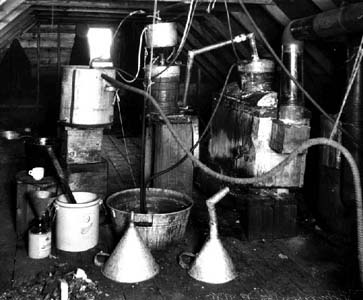Search | Image Archive | Reference | Communities | POV | Lesson Plans | Credits
 In the latter years of the nineteenth century and the first decades of the twentieth, temperance and prohibition were prominent issues on the social and political stage. The temperance movement found adherents across the political spectrum, from Social Gospellers like J. S. Woodsworth and Rev. Charles Gordon to middle class reformers like the Women's Christian Temperance Union, the Dominion Alliance and the Royal Templars of Temperance to working class organizations like the Trades and Labour Council and the Socialist Women's League.
In the latter years of the nineteenth century and the first decades of the twentieth, temperance and prohibition were prominent issues on the social and political stage. The temperance movement found adherents across the political spectrum, from Social Gospellers like J. S. Woodsworth and Rev. Charles Gordon to middle class reformers like the Women's Christian Temperance Union, the Dominion Alliance and the Royal Templars of Temperance to working class organizations like the Trades and Labour Council and the Socialist Women's League.
Prohibition has a long and complicated history in Manitoba. There were two provincial referenda on prohibition in 1893 and 1898, and it was the major election issue in 1899. Both referenda had passed, but neither had been enforced, in part due to questions about their constitutionality. In 1901, the government of Sir Rodmond Roblin faced the temperance issue. Public sentiment was strongly in favour of prohibition, but the government was reluctant to enforce the Prohibition Act, in part because the sale of liquor was a major source of tax income for the province. After putting the matter before the courts, which upheld the legality of prohibition, Roblin decided to put the matter to another vote. In 1902, Manitobans voted for a third time to "banish the bar" but this time the temperance crusaders, enraged by Roblin's actions, boycotted the vote and the measure was defeated by a narrow margin.
The crisis of the First World War was a turning point for the temperance movement. Public opinion was firmly behind them, and prohibition was passed in 1916 by the Liberal government of T. C. Norris.
Blaming alcohol for social ills was a safe and comfortable option since it did not threaten the middle class way of life or call for any dramatic social changes. Reformers linked alcohol with poverty, mental illness and crime, and they associated it with the ills of urbanization and immigration. Most temperance crusaders were of the middle classes, and a large number of these were Protestant, thus it is not surprising that some members of the temperance also held nativist views.
A majority of the temperance crusaders were women, and the history of the temperance movement is inextricably linked with the history of the suffrage movement. Temperance was infused with the message of the Social Gospel, but is was also compatible with the ideologies of maternal feminism. Urban women saw the linkages between poverty and alcoholism, while many rural women were aware of how the isolation of farm life amplified the horrors of alcohol abuse. Embracing sobriety as a solution to what they perceived as the moral decay of their society, temperance activists increasingly abandoned persuasion and education to lobby for the outright ban of the sale of alcohol. Prohibition required the passage of legislation, and thus the link between temperance and suffrage developed. The W.C.T.U was all but incorporated into the Political Equality League in the years from 1914 to 1916.
Despite its strong class and nativist overtones, the temperance movement and the feminism that drove it are not to be dismissed. That the temperance movement favoured a form of social control which would result in the creation of a stable, disciplined workforce serving the interest s of the middle classes is not questioned, but it also struggled to defeat domestic abuse, poverty and alcoholism.
Page revised: 23 August 2009